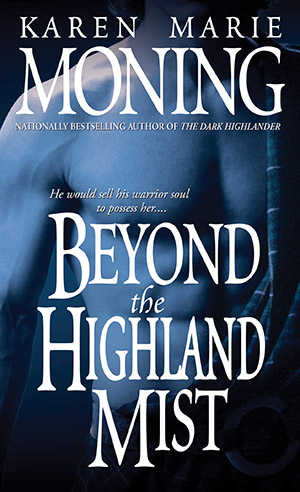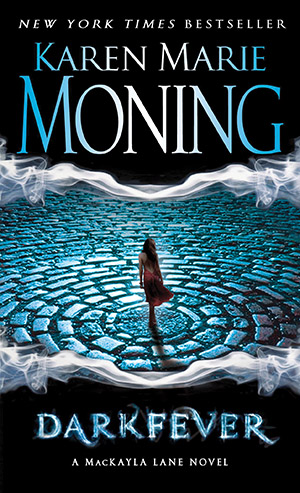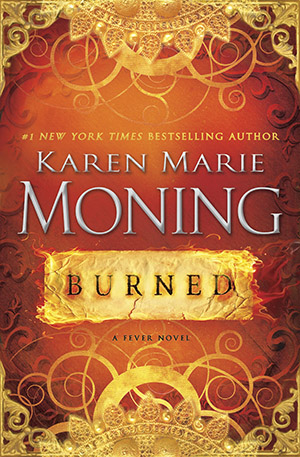Mixing Romance & Science Fiction — With a Dash of Time Travel
Prologue | Scotland | 1 February 1513
The fragrance of jasmine and sandalwood drifted through the rowan trees. Above dew-drenched branches, a lone gull ghosted a bank of mist and soared to kiss the dawn over the white sands of Morar. The turquoise tide shimmered in shades of mermaid tails against the alabaster shore.
The elegant royal court of the Tuatha Dé Danaan dappled the stretch of lush greenery. Pillowed chaises in brilliant scarlet and lemon adorned the grassy knoll, scattered in a half-moon about the outdoor dais.
— From Beyond the Highland Mist

Highlander Series
In Moning’s debut novel, Beyond the Highland Mist, a fae trickster transports a 20th century woman back to medieval Scotland where she encounters a seductive Highland laird.
The remaining seven books in the series share similar themes of Scottish lore, time travel, and passionate romance.
One look at the prose of Karen Marie Moning (LA’88), and you’d swear that it must have roots in the subconscious.
Her famous Highlander series is set in Scotland — both present and medieval — featuring characters whose lives are intertwined with the paranormal. Take Adam Black, the protagonist from The Immortal Highlander. At a given time, he has the ability to traverse continents. And time.
If Moning’s writing looks like it was born from the dream world, it may not surprise anyone to find out that it actually was.
It was a night on the brink of her 30th birthday when Moning’s life changed forever.
“I had a dream that I died and as my consciousness evaporated a huge voice said, ‘Who lived the last 10 years of your life? Because you sure as hell didn’t!’”
As Moning notes, she didn’t exactly need Freud’s help to figure out its meaning. She grew up with a love of literature, yet she had spent almost a decade working in the insurance world, composing legal briefs for inter-company arbitration.
“I woke up stunned that it was so simple. I hadn’t chosen my path. I’d let the path choose me. I quit my job the next day, took part-time work and began teaching myself how to write and get published.”
Fast forward to the present day — just like a Moning character — and the Cincinnati native is one of the queens of the paranormal romance world. A #1 New York Times bestselling author, Moning has become one of the more prolific writers of her genre, penning a collection of 15 novels, graphic novels, and novellas since 1999.
And as she looks back at that fateful dream, Moning is thankful for the compass her subconscious provided.
“It wasn’t easy,” says Moning of leaving her job in insurance.
“Groceries were scarce and rent was often late … but it was worth every moment of hunger, doubt, and rejection. I’ve been doing what I love ever since.”
Born to write
As Moning recalls, she had been bitten by the writing bug early in life, a desire that manifested itself in the form of non-stop reading.
“I was a voracious reader and not at all discerning,” says Moning of her early days.
“If it was a book, I read it.”
But as Moning notes, there was an a-ha moment that she says “shaped the writer I would become.” When she was 13, she found a copy of Harlan Ellison’s Deathbird Stories in the library of the Catholic academy she was attending. That same day, her aunt gave her mother a box of romance novels. At that moment, a writer was born.
“For the next week, I alternated between the two, reading a short story by Ellison, then a romance novel, then another short story. There are only two themes worth writing about, writer F. Gonzalez-Crussi says, ‘love and death, Eros and Thanatos.’ They are, to this day, the things I write about.”
According to Moning, she can’t recall a time when she didn’t write. As a child, she would make hand-bound books for her younger sister. During her teen years, she was writing prose, poetry, and short stories.
Armed with a love for the written word, Moning sought to sharpen her craft during her Purdue days. Though she majored in Society and Law, Moning still made sure to take classes that revolved around her true passion.
“Purdue has a terrific English department offering a variety of choices for the aspiring writer,” Moning says.
“I took two creative writing classes that stand out in my mind, one taught by a visiting poet and another by a writer on sabbatical.”
The classroom experience, Moning says, was crucial for her career.
“At the end of the semester, the poet told me to give up my dreams of writing and get a day job that paid. At the beginning of the semester, the writer told me to learn all the rules about writing — then break them. The former gave me the fire to succeed, the latter showed me the way.”

Fever Series
The five-novel urban fantasy Fever Series centers around MacKayla Lane, a reluctant sidhe-seer — a person who can see into the hidden world of the ancient, immortal fae. Mac’s quest to track down her sister’s killer in Dublin draws her into a shadowy realm of dark magic where nothing is as it seems.
Launching her career
When she made the decision to start writing 15 years ago, Moning says that she was inclined to go with science fiction, her first love. But she admits that she wasn’t confident of her ability to create an entire world. “I was, however, very certain of my romance skills,” Moning laughs.
For her, the solution was simple. She combined the two into paranormal romance. It was a genre that hadn’t really taken off at the time, years before series such as Twilight caused a craze.
“Hard to imagine now, isn’t it?” says Moning of the lack of a marketplace.
“It didn’t hurt that romance novels were 52 percent of the market — and still dominate the bestseller lists today.”
She began working on Beyond the Highland Mist, her first book which would lead to six additional novels and one novella in the Highlander series. Set in Scotland, the book followed a woman who is transported back into the 16th-century where she becomes entangled with a handsome protagonist cursed by unrequited love.It was a no-brainer when it came to setting for Moning. “As for Scotland, old Celtic legend has always fascinated me,” she says. “It was an easy move from my early Scotland-based paranormal romance novels to my current Ireland-based urban fantasy Fever series.”
Following the success of her debut — which was nominated for two RITA awards and ranked as Waldenbooks’ bestselling debut romance novel that year — Moning began to publish at a roughly one-book-a-year clip.
When asked about how she’s been able to write so consistently, Moning cites her roots.
“I have a good old-fashioned, Midwestern work ethic, which can’t be minimized,” she says.
“There’s no replacement for actually sitting in the chair and doing the writing. I’m also lucky that I write fast, once I’ve got the story planned in my head. It doesn’t hurt that I’ve also got a bit of an obsessive personality, especially concerning my creativity and writing process. When I get deep into a book, writing it is all I want to do.”
Creating her own universe
Inspiration is ubiquitous for Moning, who says she’s constantly making up stories in her mind. No matter where she is, Moning’s able to derive material for her novels, whether she’s listening to a song, or taking one of her late-night walks into the fog where she’s “imagining the many monsters a few blind steps ahead.”
“Everything is fodder: the man I sit next to on a plane, the woman at the checkout lane in the grocery store, the abnormal X-rays for someone named Alpha 49 that I discover tucked in the back of a closet in a leased vacation home,” says Moning.
When it comes time to write, Moning makes sure to get an early start on her day, waking long before the sun. She heads to her circular study, complete with floor-to-ceiling windows. The actual writing takes place in a small, dark closet on top of an aging table she once bought for $50.
To Moning, it’s imperative to wake up before the rest of the world to write.
“I wake early to get started, usually at 4:00 a.m. when my subconscious mind is governed by dream logic and primitive emotion,” says Moning.
“Neil Gaiman says ‘Writing is like flying in dreams. When you remember, when you can, when it works. It’s that easy.’”
Currently, Moning is working on the seventh book of the Fever series, which she’s set in Dublin. When it comes to planning her books, Moning says she’s not a chapter by chapter plotter. Instead, she’ll frame a book with an opening and closing, creating a structure, and then working from there. She describes her approach as “a bird’s-eye view.”

Coming in July
Moning’s next novel is the hotly anticipated Burned. It’s part two of an urban paranormal trilogy set in the Fever World centering around 14-year-old Dani O’Malley, a character introduced earlier in the Fever Series.
“When I start a new book I look for the attitudinal and situational point of entry and closure that best frames the themes underlying what I want this particular installment to accomplish,” says Moning.
“For example, when I wrote Faefever, the theme was about sacrifice, what we’re willing to give up to get what we think we want. I opened and closed the book with the same words: ‘I’d die for him,’ although uttered by different characters. Initially, you have one set of expectations about those words, one emotion. By the end, it’s a completely different situation.”
Loving her day job
The world of professional writing has been quite the change of pace from the insurance industry. However, despite her love for writing, that doesn’t mean there aren’t an array of challenges Moning faces on a daily basis.
For starters, there’s the business side to the literary world. At any time, there may be a shift in what is a hot seller and what isn’t, not to mention the struggle to compete for the attention of the consumer, she says. Then there’s the balancing act of getting the next book out quickly enough to satisfy fans without sacrificing the quality of the work.
“Attention spans are different now than they were five years ago,” says Moning. “And five minutes ago. With advancements in technology, our methods of absorption have altered. It’s like walking an ever-changing high wire. Despite the challenges, one thing remains a constant for me — I have the best job in the world.”
Though the profession is replete with challenges, Moning wouldn’t trade her day job for anything. In her words, there are two distinct parts of her profession that she loves. First, there’s the writing process itself, from creating to imagining to plotting. She describes it as the drug she can’t live without. Then there are the fans that she says are the best ever. “They come from all over the world to share their love of my series, and have formed lifelong friendships because of it,” says Moning. “I count my blessings every day.”
For those who want to follow Moning’s path and enter the profession, her advice is clear and simple.
Follow you heart.
And never quit.
“Gene Fowler said: ‘Writing is easy. All you do is stare at a blank sheet of paper until drops of blood form on your forehead,’” laughs Moning.
“But seriously, the best advice I can give is keep your butt in the chair and write, write, write. Then read, read, read. And like any dream, want it more than you want anything else. Expose yourself to a wide variety of the best, study it, dissect the art, and commit to mastering it. And if it’s really your dream — never give up!”

